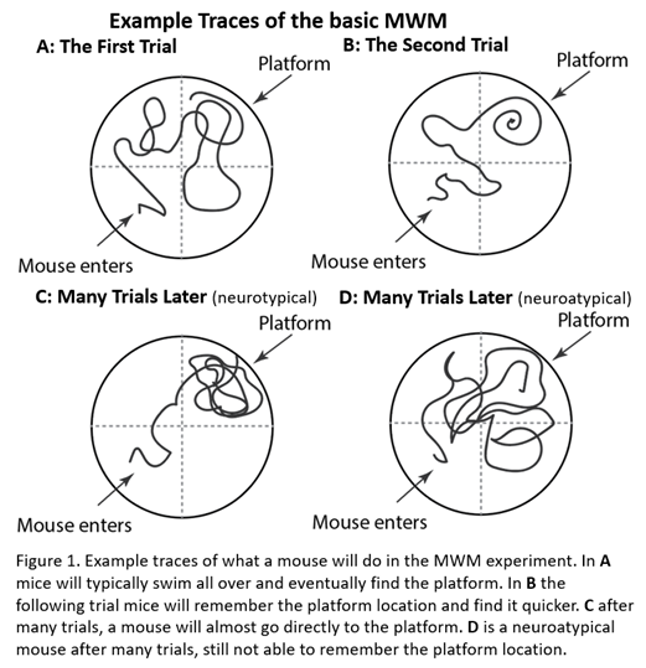By Sean Gay
Fun rating: 4/5

The actual experiment is easy to perform and generates loads of data.
Difficulty rating: 2/5

The results are difficult to interpret.
What is the general purpose? The purpose of this technique is to determine a mouse’s psychological processing and capacity for spatial learning and memory.
Why do we use it? The Morris Water maze (MWM) is a common, well-accepted technique, where the performance of the mouse is strongly tied to hippocampal and cognitive function. As such, the MWM is commonly used to test a mouse’s memory and ability to learn. It is often used with other behavior experiments to determine if a mouse’s brain function is neurotypical (properly working) or neuroatypical (abnormally working).
Definitions:
Cognitive function: the brain’s ability to perform functions like learning and memory.
Neurotypical: describes a mouse that performs a cognitive behavioral test as expected (i.e. finding the platform in this experiment).
Neuroatypical: describes a mouse that does not achieve the expected results in a cognitive behavioral test (for instance, not finding the platform in this experiment). These are typically mice with a genetic mutation, but can occur in non mutated mice if injected with certain compounds.
Spatial learning and memory: the capacity to learn a novel environment and remember it at a later time.
How does it work?
- Basic MWM:=
The experiment begins by putting a mouse into a deep pool of water that they must swim in. Hidden to the mouse is a platform in one quadrant of the pool that is shallow enough for the mouse to walk on (Figure 1). Mice do not like treading water and will swim frantically trying to escape. During this panicked swim, they will find the walkable platform (Figure 1.A). A scientist then records the amount of time it takes the mouse to find the platform.

In following experiments, the mouse is put in the same pool with the platform in the same location. A neurotypical mouse, or a mouse with a regular brain function, will remember the dreaded experience from the first trial (Figure 1.B). So, when the mouse is frantically swimming, they will remember the location of the platform and find it quicker. With each following trial, a normal mouse will continue to improve (Figure 1.C). However, some neuroatypical mice, or mice that do not have normal brain function, will not improve with more trials (Figure 1.D). This would indicate that these mice have a deficiency in spatial reference memory, i.e., they cannot remember the placement of things in space.

- MWM Probe Experiment:
The MWM assay can be tweaked to further examine cognitive function. After training the mice in the initial trials, you can remove the platform entirely (Figure 2). Neurotypical mice will remember the previous trials and swim to the quadrant where the platform should be. The time that the mouse is in that quadrant can be measured and used as another way to measure spatial memory. Eventually, they should realize no platform is there and begin frantically swimming around the pool. This measurement is another way to determine spatial memory that is independent of swimming speed and tests the mouse’s non-reinforced memory (i.e. the mice cannot walk on the platform to know it is there;they have to remember the location).
- MWM Reversal Experiment:

Another major tweak to the MWM is called the reversal (Figure 3), which would typically be conducted after the previous experiments. In this experiment, the platform is moved to a different quadrant of the pool. Like the probe experiment, the mouse will head to the quadrant where the platform had been in the previous trials but the platform won’t be there (Figure 3.A). Once the mouse realizes this, they will frantically swim and eventually find the newly located platform (Figure 3.A). After several trials with the platform in the new location, the mouse will slowly learn the new location and begin to swim directly to it (Figure 3.B,C). The number of trails and length of time it takes the mouse to physically find the underwater platform are recorded. Combined, these experimental results are great measures of the brain’s plasticity, meaning the brain’s ability to learn. Neuroatypical mice will either not learn where the new platform is and not go to the correct quadrant or they will continually go to the location of the old platform, showing that they don’t have the same ability to learn (Figure 3D).
Conclusions:
Overall, the MWM and its variations are fantastic ways to measure a mouse’s spatial learning and memory. The method is used in a lot of studies, especially studies that analyze how a genetic mutation, drug, or external factor (e.g., sleep loss) impacts these cognitive functions. The results of these experiments can be complicated.However, you can conclude a lot about the cognitive ability of mice, including their cortical and hippocampal function, and ability to process spatial memory.
